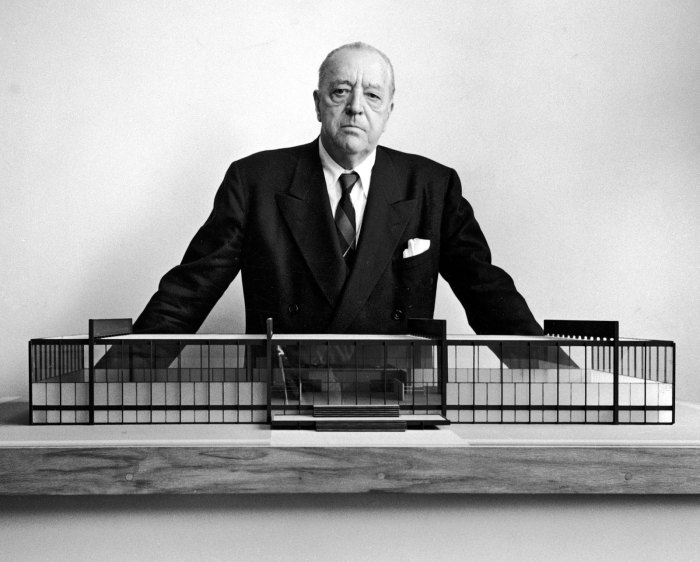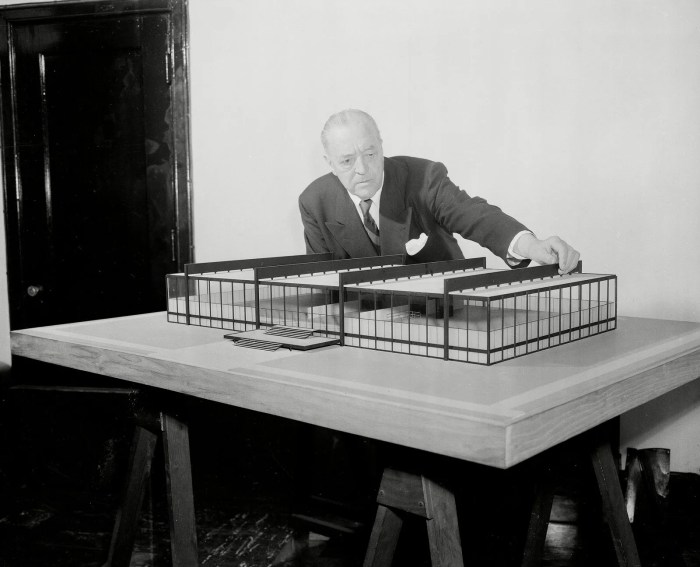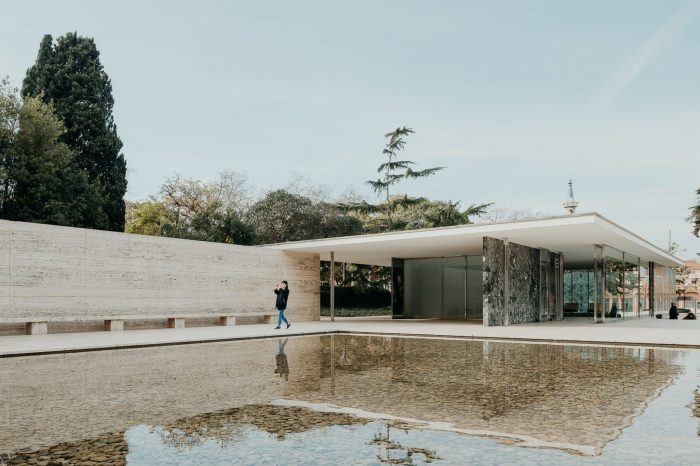Exploring the Legacy of Mies van der Rohe
Mies van der Rohe, a pioneer of modern architecture, left an indelible mark on the architectural world with his innovative designs and minimalist approach. Delve into the life and works of this iconic architect as we uncover the profound impact he has had on the realm of architecture.
As we journey through his early beginnings, architectural masterpieces, and lasting influence, we will gain a deeper appreciation for the genius of Mies van der Rohe.
Background of Mies van der Rohe

Mies van der Rohe, born as Ludwig Mies, was a German-American architect known for his significant contributions to modern architecture. He was born on March 27, 1886, in Aachen, Germany. Mies started his career as an apprentice in various design firms, where he gained valuable experience in architectural design.
Early Life and Education
Mies van der Rohe began his architectural journey working in the studio of Peter Behrens, a pioneer of modern architecture. It was here that Mies was exposed to the principles of functionalism and the importance of simplicity in design. His early education and apprenticeship laid the foundation for his later groundbreaking work in architecture.
- Studied at the School of Construction in Aachen and later at the Technical University in Berlin.
- Affected by the works of architects like Frank Lloyd Wright and Le Corbusier, Mies developed his unique style known for its minimalism and clarity.
- Embraced the use of industrial materials such as steel and glass, creating open and flexible spaces.
Architectural Influences and Style
Mies van der Rohe's architectural style was greatly influenced by the modernist movement and the Bauhaus school of design. He believed in the motto "less is more," emphasizing simplicity, clean lines, and the use of modern materials in his designs.
"God is in the details."
Mies van der Rohe
- Known for his use of open floor plans and the concept of "universal space" that flowed seamlessly from one area to another.
- Pioneered the idea of the "skin and bones" architecture, where the structural framework of a building is left exposed.
- His designs focused on the integration of interior and exterior spaces, blurring the boundaries between the two.
Significant Contributions to Modern Architecture
Mies van der Rohe's impact on modern architecture is profound, with his designs shaping the way we think about space and structure in buildings.
- Designed iconic buildings such as the Barcelona Pavilion and the Seagram Building in New York City.
- His work laid the foundation for the International Style of architecture, which focused on functionalism, simplicity, and the use of modern materials.
- His influence can be seen in countless skyscrapers and public buildings around the world that embrace the principles of modernism.
Architectural Works

Mies van der Rohe is renowned for his iconic architectural projects that have left a lasting impact on the architectural world. His designs are characterized by the use of modern materials, open spaces, and minimalism, creating a sense of simplicity and elegance in his structures.
Iconic Projects
- The Barcelona Pavilion: Built for the 1929 International Exposition in Barcelona, Spain, this pavilion is a masterpiece of modern architecture. It features a minimalistic design with an open floor plan, supported by sleek steel columns and glass walls.
- The Farnsworth House: Located in Plano, Illinois, this residential masterpiece is a prime example of Mies' minimalist approach. The house is elevated on stilts, allowing for an open floor plan and a seamless connection to the surrounding nature.
- The Seagram Building: Situated in New York City, this skyscraper is a symbol of modernist architecture. With its bronze and glass facade, the building stands out in the city skyline, showcasing Mies' attention to detail and use of high-quality materials.
Design Characteristics
- Mies van der Rohe's designs often feature clean lines, flat roofs, and open floor plans that blur the boundaries between interior and exterior spaces.
- His use of materials such as steel, glass, and concrete reflects a commitment to simplicity and honesty in design, showcasing the beauty of industrial materials.
- The emphasis on open spaces and minimalistic details in his buildings creates a sense of timeless elegance and sophistication, setting a new standard for modern architecture.
Impact on Architecture
- Mies van der Rohe's architectural works have had a profound influence on the modern architectural world, inspiring generations of architects to embrace minimalism and simplicity in their designs.
- His innovative use of materials and focus on open spaces have redefined the way we think about architecture, emphasizing the importance of functionality, efficiency, and aesthetic appeal.
- His buildings continue to be celebrated for their timeless beauty and enduring relevance, serving as a testament to Mies van der Rohe's lasting legacy in the world of architecture.
Bauhaus Influence
Mies van der Rohe's time at the Bauhaus school of design played a significant role in shaping his architectural principles and design philosophy.
Role at the Bauhaus
Mies van der Rohe became the director of the Bauhaus school of design in 1930, succeeding Walter Gropius. During his tenure, he shifted the focus towards architecture and emphasized the integration of art, craft, and technology. Mies believed in the idea of creating a total work of art, where all elements of a building were harmoniously designed to form a unified whole.
Influence on Architectural Principles
The Bauhaus movement's emphasis on functionality, simplicity, and the innovative use of materials greatly influenced Mies van der Rohe's architectural principles. He adopted the Bauhaus's minimalist approach and applied it to his designs, prioritizing clean lines, open spaces, and the use of modern materials such as steel and glass.
This influence can be seen in iconic works like the Barcelona Pavilion and the Farnsworth House, where form follows function and every element serves a purpose.
Comparison Before and After Bauhaus
Before his time at the Bauhaus, Mies van der Rohe's designs were more traditional and ornate, reflecting the prevailing architectural styles of the time. However, after his experience at the Bauhaus, his work underwent a radical transformation. He embraced the Bauhaus principles of simplicity, functionality, and the unity of art and technology, leading to the development of his distinctive modernist style.
This shift marked a pivotal moment in his career and solidified his reputation as one of the most influential architects of the 20th century.
Significance in Modern Architecture

Mies van der Rohe's influence in modern architecture is undeniable, as his design principles have shaped the way architects approach space, materials, and structure. His minimalist approach and focus on open spaces have become defining characteristics of contemporary architectural design.
Adaptation of Design Principles
Mies van der Rohe's emphasis on simplicity, clean lines, and the use of modern materials such as glass and steel has been widely adopted in contemporary architecture. Architects today continue to draw inspiration from his iconic buildings like the Farnsworth House and the Barcelona Pavilion, integrating similar design elements into their work.
Evolution in Contemporary Architecture
While Mies van der Rohe's architectural style was revolutionary in his time, it has evolved in contemporary architecture to incorporate new technologies and sustainability practices. Architects now combine his design principles with innovative building techniques to create structures that are not only aesthetically pleasing but also environmentally friendly and efficient.
Legacy in the Architectural World
Mies van der Rohe's legacy in the architectural world is enduring, with his influence seen in skyscrapers, museums, and residential buildings around the globe. His commitment to simplicity, elegance, and functionality continues to resonate with architects and designers, ensuring that his impact on the field will be felt for generations to come.
Closure
In conclusion, the legacy of Mies van der Rohe continues to shape the way we perceive and create architecture today. His timeless designs and revolutionary principles serve as a testament to his enduring influence in the architectural landscape.
FAQ Corner
What were some of Mies van der Rohe's major architectural projects?
Mies van der Rohe is renowned for iconic works such as the Barcelona Pavilion, the Farnsworth House, and the Seagram Building.
How did the Bauhaus movement influence Mies van der Rohe's design philosophy?
The Bauhaus emphasis on functionalism and simplicity greatly influenced Mies van der Rohe's minimalist and rational approach to architecture.
What is Mies van der Rohe's lasting legacy in the architectural world?
His emphasis on open spaces, clean lines, and use of modern materials continues to inspire architects and designers worldwide.




